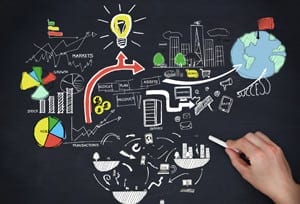 While marketing automation has historically been aimed at alleviating marketers from repetitive tasks, it has begun its evolution into consumer-facing roles. One such example can be seen in brands like Disney exploring ways to scale direct consumer interactions with automated content marketing through chatbots on Facebook Messenger.
While marketing automation has historically been aimed at alleviating marketers from repetitive tasks, it has begun its evolution into consumer-facing roles. One such example can be seen in brands like Disney exploring ways to scale direct consumer interactions with automated content marketing through chatbots on Facebook Messenger.
As people, behavior and interactions change, the way brands interact with customers must also evolve. For marketing automation to be effective, marketers must deliver more personalized experiences at scale, driven by efficiency and data. Here are five ways to adapt:
- Personalize through data. Traditional demographics-based targeting is losing its effectiveness as consumers desire deeper, more personalized experiences. If your automated marketing campaigns aren’t narrowed down to specific consumer interests, your communications become nothing more than spam.
Without relevance and immediate value, your campaigns will quickly be ignored, leading to degrading brand perception. In order to avoid this trap, utilize proprietary consumer behavior data to personalize ads, content and offers. One great example is the way music streaming app Spotify automatically creates custom ads based on each user’s current playlist. By leveraging existing user data to personalize automated ads, your brand will be delivering enticing information that’s both timely and relevant to your customer.
- Utilize messaging. According to a recent IHS report, messaging apps such as Facebook Messenger, WeChat and Snapchat reached a combined 4.2 billion monthly active users at the end of 2015. It’s projected that by 2018, there will be 1.1 billion new users. Messaging platforms are now central hubs where consumers actively engage with one another, and the vast majority of millennials are messaging on their smartphones daily. These platforms are beginning to enable more than just conversation between two individuals.
Popular messaging apps now enable everything from news distribution and money transfers to live customer service. Since messaging has transformed to become an integral part of daily life, brands must develop strategies that engage consumers on this medium. And while messaging campaigns can seem like a daunting and resource intensive task, chatbots are capable of delivering scalable and fully automated experiences that are completely aligned with the brand voice.
Universal Studios was able to generate buzz for the 30 year anniversary re-release of the Back to the Future trilogy with an AI-powered Doc Brown chatbot on Facebook Messenger. These kinds of chatbots can be a very effective method for engaging consumers in entertaining, two-way conversations.
- Double down on AI. Creating personalized messages for thousands of customers can be a time consuming task for marketers. But with advances in AI and natural language processing (NLP) technology, it’s become much easier. AI-powered platforms can identify and respond to consumer intent in real-time and deliver relevant offers in a way that was never before possible. Automated platforms that utilize Dynamic AI, like chatbots, do this by referencing a history of past interactions to generate smart, contextual responses to user messages.
Many leading companies are now utilizing this technology. Microsoft’s Xiaoice chatbot has more than 20 million users and 10 million instances where people have actually said they “love” their virtual friend. By integrating a Dynamic AI that has the ability to interact with millions of consumers simultaneously in real-time, brands will now be able to create easily scalable and highly engaging dialogues.
- Go mobile. Mobile phone use may have grown over the past few years to quickly surpass desktop usage, but even more impressive is the rate of growth of connected devices such as wearables. With a plethora of new data that’s now available through these Internet-connected devices, it’s critical that brands integrate this valuable data into their marketing strategy to more effectively target potential customers.
One way to utilize this data is if a FitBit user just completed a workout, they could automatically be served up ads on their smartphone with coupons for post-workout smoothies at nearby places based off geolocation data. This enables your brand to effectively deliver messages where and when they have the highest chance of relevancy to the consumer, otherwise known as location-based advertising.
Traditional marketing channels and methods are losing their effectiveness, particularly with millennials, and will continue fading as both technology and consumer behavior change. The future of personalized marketing campaigns will undoubtedly be powered by automated processes that enable brands and marketers to deliver relevant and engaging brand experiences to consumers at scale, without sacrificing authenticity.
Eyal Pfeifel is co-founder and CTO of Imperson.
This article was originally published in 2016 and is frequently updated.
Related Articles:
3 Ways to Reap the Benefits of Marketing Automation in 2017
Automation Helps Vodaphone Manage ROI Globally
What Springsteen Knew About B2B Automation



